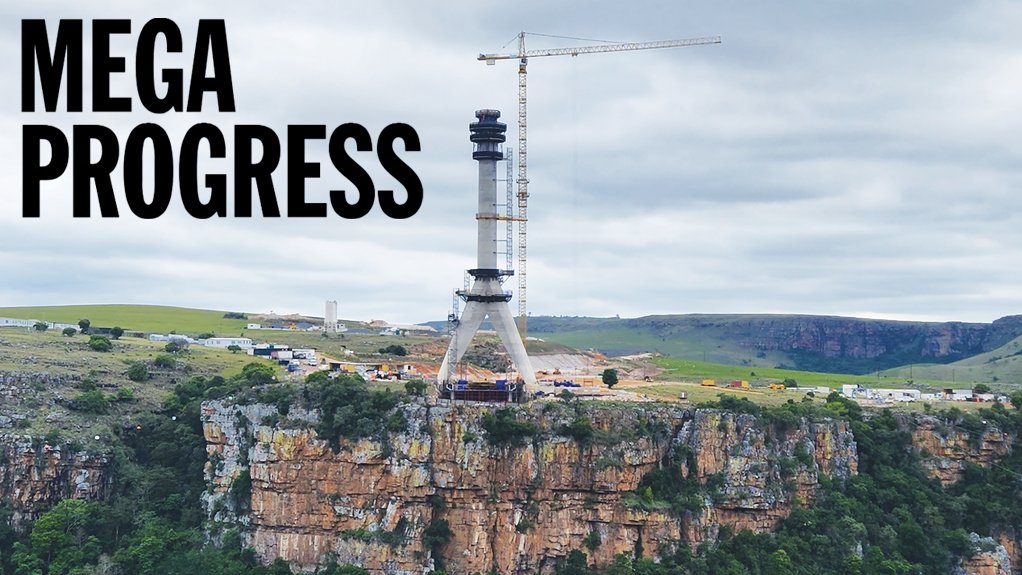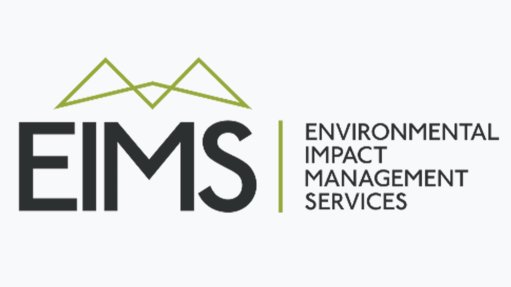Eastern Cape megabridges making steady construction progress after initial setbacks
Following delays and setbacks in recent years, roads parastatal South African National Roads Agency Limited (Sanral) restarted works last year on the Mtentu and Msikaba megabridges, in the Eastern Cape, as part of the flagship N2 Wild Coast Road (N2WCR) project.
The project covers 410 km between the N2 Gonubie Interchange near East London, in the Eastern Cape, and the Mtamvuna river bridge, and stretches to Port Edward, in KwaZulu-Natal.
The N2 route connects the Western Cape, the Eastern Cape, KwaZulu-Natal and Mpumalanga, running through the cities of Cape Town, George, Port Elizabeth, East London, Mthatha, Durban and Ermelo.
The bridges are set to be extraordinary technical feats in South Africa; they will form part of the 112 km of new highway between Port St Johns and Port Edward.
Although the bridges were designed in 2004 and works started in earnest in 2019, various setbacks and delays have impacted on the construction timeframes and costs since then.
The Msikaba bridge, which will span the 198-m-deep Msikaba river gorge, is being constructed by the Concor-Mota Engil joint venture as the main contractor.
Msikaba project director Laurence Savage regards the bridge as possibly the most complex structure of its type ever to be built in Africa.
At 580 m in length, it will be the longest cable-stayed bridge, in terms of main span, in Africa, and will have the second-longest main span of any bridge on the continent. It also ranks as one of the highest bridges in Africa, only exceeded by the Bloukrans bridge, also in South Africa, at 216 m.
The Msikaba bridge construction is earmarked for completion by the end of this year.
For its part, the Mtentu bridge, once completed by Mota-Engil Construction South Africa and China Communications Construction Company as the main contractors, will be the highest in Africa and one of the longest main-span balanced cantilever bridges in the world, with a main span of 260 m at a maximum height of about 223 m.
Denmark-based architecture company Dissing+Weitling designed both bridges.
Construction Method
Limited environmental disturbance, aesthetics and climate resilience were among the prime factors taken into account when the bridges were designed during the concept stage, says Sanral southern region manager Mbulelo Peterson.
Sanral considered three concepts using three-dimensional modelling, and ultimately chose a balanced cantilever combination with incremental launching for the Mtentu bridge; other options were a cable-stay or concrete arch bridge.
Owing to the high elevation above the valley floor, the Mtentu bridge was modelled and subjected to wind tunnel testing, with other extreme weather conditions also factored into the modelling.
Using a balanced cantilever method of constructing the bridge, the concrete box deck is built out from a pier in stages to ensure that the deck’s dead weight is balanced above the pier support for every concrete segment cast to minimise out-of-balance forces.
A benefit of this type of bridge is that its different parts can be constructed simultaneously, which helps to minimise the construction period.
Additionally, the maximum span of 260 m of the balanced cantilever method is much longer than what is possible in other concrete bridges. It is generally used when fewer piers are required across an environmentally sensitive valley.
The Mtentu bridge contract has an estimated budget of R4.05-billion, with a local labour contract participation goal of 4%. This will result in at least R141-million being paid to local labour, creating a minimum of 1 550 full-time-equivalent jobs for local skilled and unskilled persons during the contract.
About 2 350 full-time-equivalent jobs will be created during construction, and while job numbers will vary during the contract, an average of 520 jobs will be created every month over 50 months, of which 350 will be filled by locals.
For the Msikaba bridge, the cable-stay option was selected. The other options that were considered included a suspension bridge with a steel deck, and a steel arch bridge, both of which are significantly more expensive.
The cable-stay method is not only aesthetically pleasing and the most economical but also requires no work in the valley below.
The bridge is being built from the north and south banks of the gorge and comprises two identical halves, each spanning 290 m. The halves will meet midpoint over the gorge.
Each half is supported by 17 pairs of cables attached to 127-m-high, inverted-Y-shaped concrete pylons, one on each side of the gorge.
The pylons are back-stayed into the anchor blocks by 34 pairs of cables – 17 on either side of the gorge.
The Msikaba bridge has an estimated value of R1.75-billion, of which R86-million of the contract value has been set side for targeted local labour and R515-million for subcontracting to targeted enterprises.
To date, R553-million has been spent on 157 targeted enterprises, comprising 44 suppliers, 52 service providers and 61 subcontractors. About R93-million has been spent on wages for local labour, in addition to the targeted spend.
Of the 453 full-time-equivalent jobs that have been created on the Msikaba bridge to date, 391 are occupied by locals.
Economic Benefits
The N2WCR project is poised to be hugely beneficial for the national and Eastern Cape economies, particularly since its contract participation goal is a minimum of 30%.
Once complete, about seven interchanges and various access roads will ensure a faster and safer experience for people travelling in the Wild Coast region.
The construction of the road is creating thousands of jobs and injecting much-needed funding into the local economy.
With the projects having a minimum 30% expenditure stipulated for targeted enterprise subcontractors and suppliers, it will result in more than R4-billion flowing to small, medium-sized and microenterprises (SMMEs), mostly from the OR Tambo and Alfred Nzo districts.
There are also several peripheral projects associated with the construction of the N2WCR, including housing relocation, building access roads, crushed rock material supply and several community development projects to train, mentor and grow contractors.
These standalone projects, together with further community development projects implemented through the main works contracts, will result in an estimated 30 peripheral projects that will be undertaken in the area between Port St Johns, Winnie Madikizela-Mandela – formerly Mbizana – and Ingquza Hill local municipalities, predominantly by local SMMEs.
Construction work will create about 8 000 direct full-time-equivalent jobs, and between 21 300 and 28 100 indirect jobs. Once the road is completed, ongoing operational work is expected to create 900 direct jobs and up to 18 900 indirect jobs.
The numerous new interchange bridges and upgrading or construction of linking access roads that form part of the N2WRC project will provide connectivity and mobility, as well as access to social and economic opportunities for local communities.
Setbacks and Challenges
Finding experienced contractors for such large-scale construction projects necessitated a prequalification requirement, which included demonstrable experience of working at height, says Peterson.
Working at height is particularly challenging for the contractors on both bridges, and their designs of temporary works were critical to ensure safe construction. The remoteness of the sites also posed some challenges.
Peterson adds that the technical and commercial risks have to be carefully monitored.
The N2WCR project faced a particular setback when a moratorium on all major construction work was imposed during the State of Disaster, which was declared in 2020 to curb the spread of Covid-19.
The Mtentu bridge construction thus effectively started on August 5 last year.
Peterson says while there were delays, owing to slow progress by the contractor, the programme could still be brought back on schedule within six months.
The Aveng Strabag joint venture was originally responsible for building the structure, but abandoned the project in early 2019, following months of community protests.
There were also delays in the construction of the Msikaba bridge because of Covid-19, and the contract was also impacted on by delays caused by surging winds of up to 80 km/h up the gorge, which were so strong that work had to be suspended.
Occasionally, mist covering the gorge also resulted in work having to be suspended.
Sanral also had to deal with labour unrest during the early stages of the bridges’ construction, but has nonetheless consulted extensively with the Amadiba communities, their traditional leaders and elected leaders dating back to the initial environmental- impact assessment public participation and key stakeholder engagements.
After community disruptions stopped construction of the Mtentu bridge in 2018, there were numerous engagements between local stakeholders and the N2WCR Political Oversight Committee, which was established by the Premier of the Eastern Cape.
Sanral hosted various engagements throughout the following years to discuss various aspects of the proposed road with these communities, including a community imbizo headed by the former Transport Minister in November 2022, which was held at the Winnie Madikizela Mandela local municipality to introduce the contractor to the local community.
Peterson explains these engagements were over and above the quarterly Wild Coast stakeholder meetings, monthly business chamber meetings and ad hoc stakeholder meetings with the Wild Coast Business Chamber, the Amadiba Traditional Authority, and the Umbono Wethu and Amabida business forums.
Sanral set up project liaison committees for every project, comprising representatives of local communities, traditional authorities, business and other key stakeholders, with which it meets regularly to ensure issues arising within communities can be raised and resolved amicably.
Members of these committees include MECs from the Eastern Cape provincial government and the mayors of the OR Tambo and Alfred Nzo districts, as well as local municipality mayors.
Meanwhile, as reinforcing steel is readily available in South Africa, none has had to be imported for the two bridge projects, Peterson says.
However, cable-stay strands manufactured in South Africa for the Msikaba contract have failed some suitability tests after several attempts and, therefore, will be imported.
All the steel for the Mtentu bridge contract will continue to be sourced in South Africa.
Article Enquiry
Email Article
Save Article
Feedback
To advertise email advertising@creamermedia.co.za or click here
Comments
Press Office
Announcements
What's On
Subscribe to improve your user experience...
Option 1 (equivalent of R125 a month):
Receive a weekly copy of Creamer Media's Engineering News & Mining Weekly magazine
(print copy for those in South Africa and e-magazine for those outside of South Africa)
Receive daily email newsletters
Access to full search results
Access archive of magazine back copies
Access to Projects in Progress
Access to ONE Research Report of your choice in PDF format
Option 2 (equivalent of R375 a month):
All benefits from Option 1
PLUS
Access to Creamer Media's Research Channel Africa for ALL Research Reports, in PDF format, on various industrial and mining sectors
including Electricity; Water; Energy Transition; Hydrogen; Roads, Rail and Ports; Coal; Gold; Platinum; Battery Metals; etc.
Already a subscriber?
Forgotten your password?
Receive weekly copy of Creamer Media's Engineering News & Mining Weekly magazine (print copy for those in South Africa and e-magazine for those outside of South Africa)
➕
Recieve daily email newsletters
➕
Access to full search results
➕
Access archive of magazine back copies
➕
Access to Projects in Progress
➕
Access to ONE Research Report of your choice in PDF format
RESEARCH CHANNEL AFRICA
R4500 (equivalent of R375 a month)
SUBSCRIBEAll benefits from Option 1
➕
Access to Creamer Media's Research Channel Africa for ALL Research Reports on various industrial and mining sectors, in PDF format, including on:
Electricity
➕
Water
➕
Energy Transition
➕
Hydrogen
➕
Roads, Rail and Ports
➕
Coal
➕
Gold
➕
Platinum
➕
Battery Metals
➕
etc.
Receive all benefits from Option 1 or Option 2 delivered to numerous people at your company
➕
Multiple User names and Passwords for simultaneous log-ins
➕
Intranet integration access to all in your organisation

















